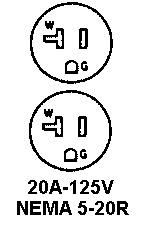You have a good point. It would be wrong and dangerous (fire wise) to backfeed a (house) branch circuit with anything more than a 2000 watt generator (or from a generator outlet with more than a 20a breaker on it.) Even then one should make sure they are feeding a 20a rated house outlet.
They say a little knowledge is a dangerous thing. I think we're firmly in that territory now. Assuming that you're backfeeding via a 110v receptacle, which would only feed half the circuits in the house, by the way, you would want to make sure that your supply current was less than the breaker on the circuit you're backfeeding, since the wire on that circuit will have been sized to match the breaker. You say a 2000W genny, but bear in mind that most generators are 240v, and will have two separate 120v legs, each carrying half the generator's rated wattage. So assuming a 20A breaker on a 120v circuit (equals 2400W), you could have up to a 4800W generator without overloading the wiring.
I'll admit that I don't have much experience with a wide range of generators but all that I have seen only have 15 or 20 amp outlets for 110v.
That's my experience too. Standard 120v receptacles are almost always rated for 10 or 15 amps. The 20-amp receptacles have one of the prongs at a right angle, as shown here:
So even if the generator was more than 4800W, it probably won't be putting more than 15 or 20 amps on a single 120v leg. BTW, there is a 30-amp 120v plug and receptacle, but you hardly ever see them.
Beyond that, you need to go to a heavier rated 220v outlet and 220v connection which is not what you can feed a typical house branch circuit. Hopefully anyone feeding their house via such a generator connection realizes that they need special wiring and hookup if they want more than 110v 20 amp service or they need the proper wiring and plug to feed a range or dryer outlet.
No. Hopefully anyone feeding their house this way realizes that the whole idea of backfeeding via a suicide cord is dumb and dangerous and they will think better of it. The reasons we have laid out here are just some of the things that can go wrong. There are many more. If the power is out and your sainted grandmother needs her dialysis machine to live, and the only way to run it is to backfeed, then it might be worth it. But really, you should plan ahead for these things and get an interlock or transfer switch and do it right.
Bottom line, if you want more than 110v 20 amp (2000 watts), you really need to get a proper connection into your breaker box.
Bottom line: you really need to get a proper connection into your breaker box, PERIOD.
